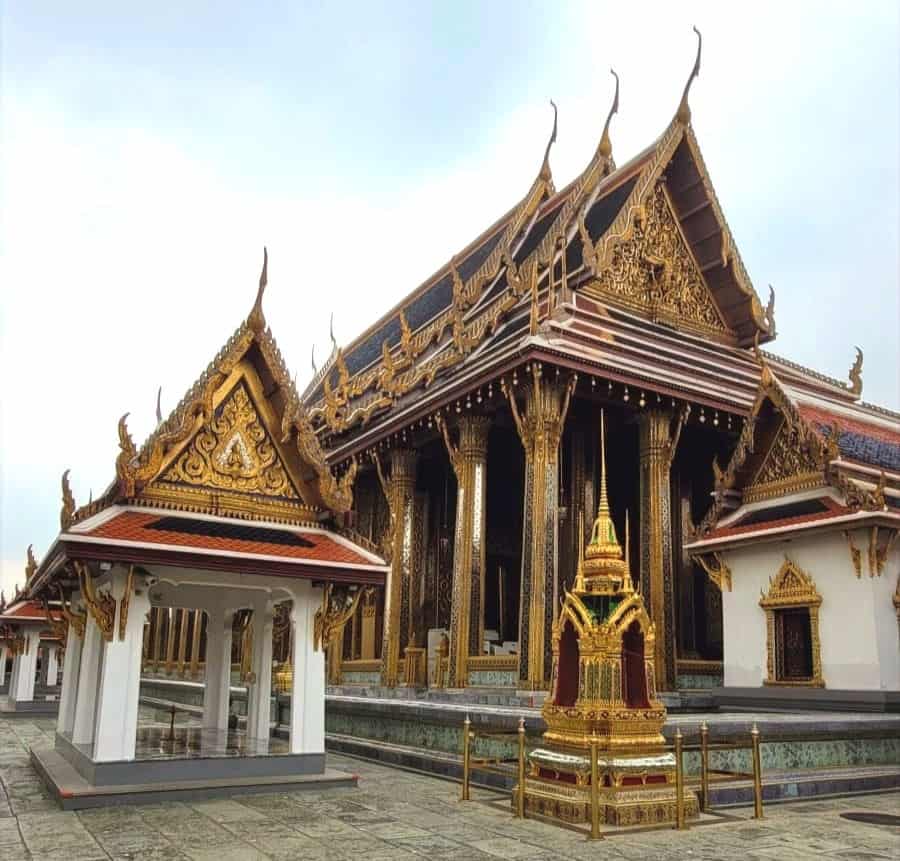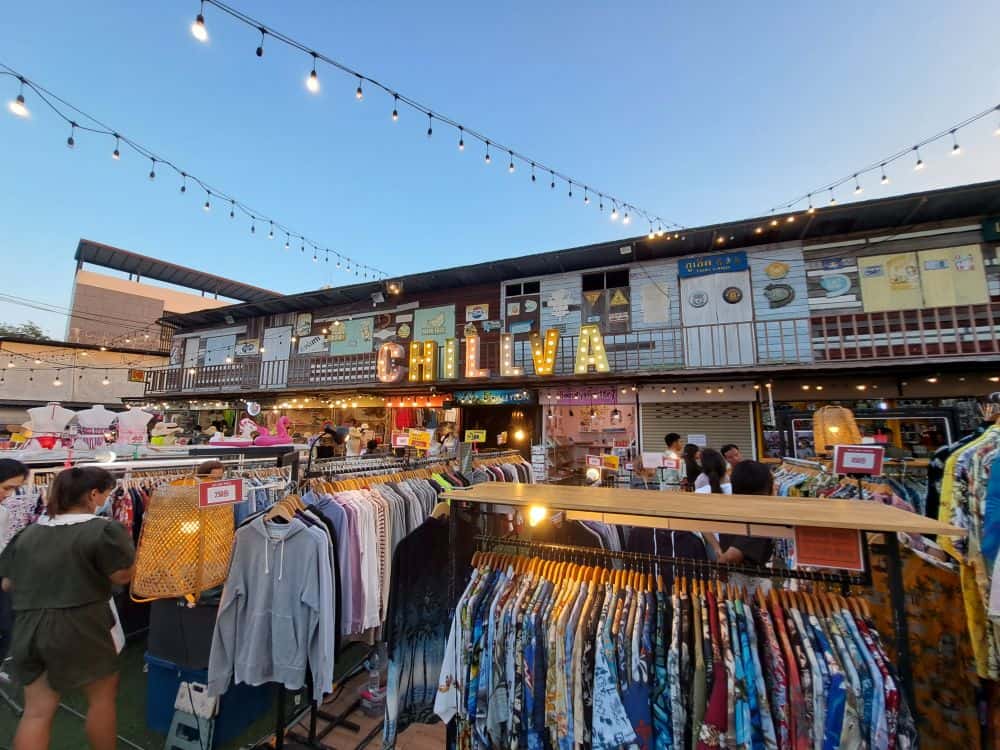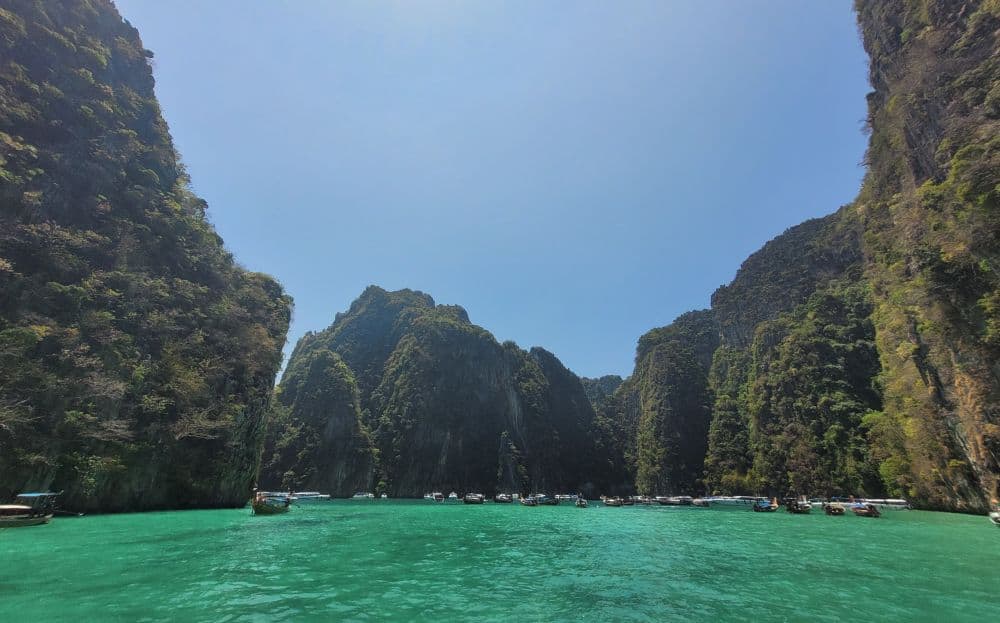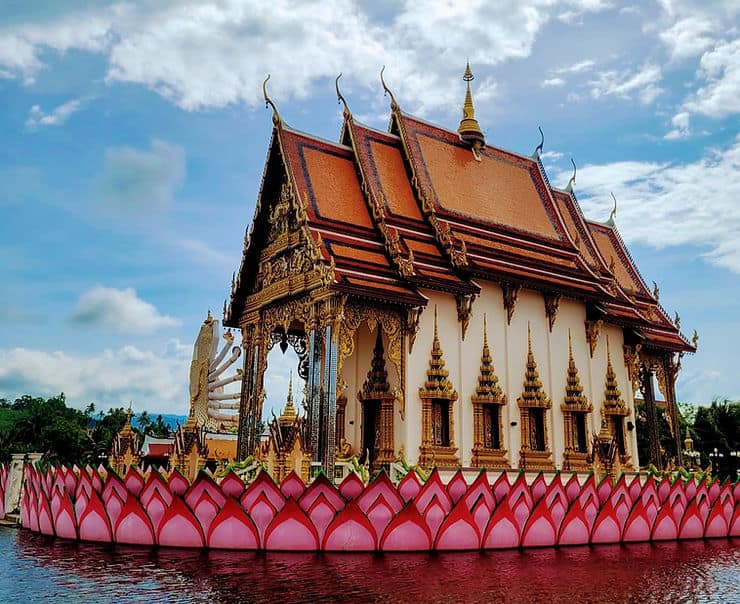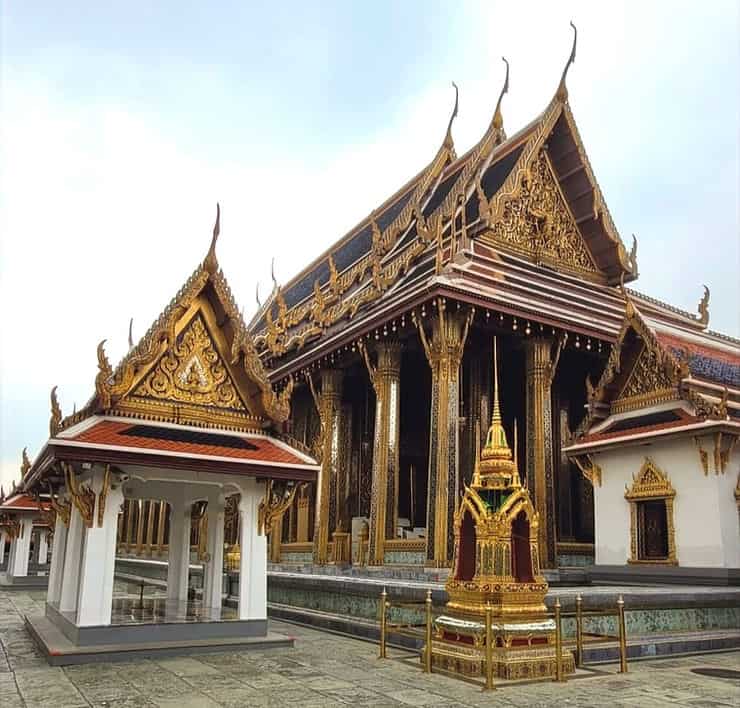
This post may contain affiliate links. I will receive a small commission if you use these links.
Thailand’s capital, Bangkok, is a lively city, known for its sprawling shopping malls, amazing street food, classy rooftop bars, parties and markets. But, nightlife aside, there are many beautiful shrines and temples in Bangkok.
Chiang Mai, in the north of Thailand has earned the reputation of the ‘City of Temples’, due to the number of beautiful temples in the city, however you might be surprised to hear that Bangkok actually has over 400 temples! The most well known (and most visited) are located in the heart of the city; Wat Phra Kaew (also known as the Temple of the Emerald Buddha, in the centre of The Grand Palace complex), Wat Arun and Wat Pho.
These three temples in Bangkok are not only breathtaking, but they are also conveniently located near each other, so visiting all three in a day is easy!
Bangkok is a large city, so to maximise your time in here, make sure that you choose your accommodation close to the sights you most want to visit, or at least close to public transport. Check out some of the best places to stay in Bangkok.
How to visit Bangkok’s three top temples; Wat Phra Kaew, Wat Arun and Wat Pho, in one day
You can’t visit Bangkok without visiting its most famous temples. Wandering around The Grand Palace and Wat Phra Kaew, Wat Arun and Wat Pho is definitely one of the best things to do in Bangkok. They are all worthy additions to your Thailand bucket list.
Plus, if you are short on time, you can easily see all three temple sites in one day, as they are just a short distance from one another. Meaning that you will still have time to sample Bangkok’s amazing street food at the end of the day!
I’ve listed the three temples in the order I visited them. I would recommend visiting them in this order due to the opening hours of each one.
Itinerary for visiting the top three temples in Bangkok:
1. Wat Phra Kaew & The Grand Palace
Start your day by visiting Wat Phra Kaew (The Temple of the Emerald Buddha) and The Grand Palace. Spend a couple of hours here, exploring the vast complex, before making your way to Wat Arun.
2. Wat Arun
From The Grand Palace, walk 10 minutes to Tha Tien pier. From here, it’s just a 5 minute ferry crossing to Wat Arun on the other side of the Chao Phraya river.
Wat Arun is the smallest of the three temples, so you probably won’t need more than 1 hour here, but it is stunning and definitely worth the trip across. There’s also a nice little cafe within the grounds, so it’s the perfect place to get a cold drink and have a rest in the shade.
3. Wat Pho
The final temple of the day is Wat Pho. From Wat Arun Pier, take the ferry back to Tha Tien Pier and walk just a couple of minutes to the entrance of Wat Pho. The highlight of Wat Pho is the Temple of the Reclining Buddha. This impressive statue is the reason that Wat Pho is one of the most visited temples in Bangkok. After you’ve visited the reclining Buddha, stay to wander around the rest of the temple complex – you can even get a massage here if your feet are aching at the end of the day!
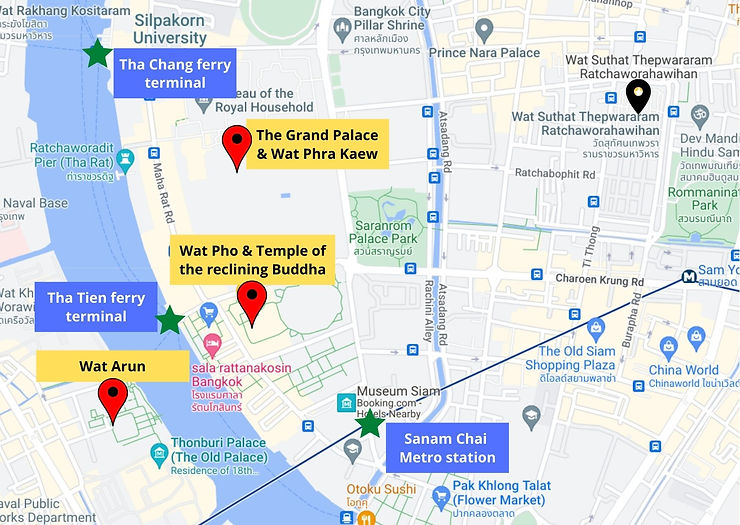
1. Wat Phra Kaew (The Temple of the Emerald Buddha) & The Grand Palace
Although Wat Phra Kaew (The Temple of the Emerald Buddha) is located inside the complex of The Grand Palace, The Grand Palace itself is not a temple. It is, as the name suggests, a royal palace. It was built in 1782 for King Rama I who decided that he didn’t want to reside at the existing royal palace in Thonburi, and instead, wanted to build his own palace, on the other side of the Chao Phraya River. The new palace was to be not only a royal residence but also a site for the administrative offices, and hence The Grand Palace Complex was created.
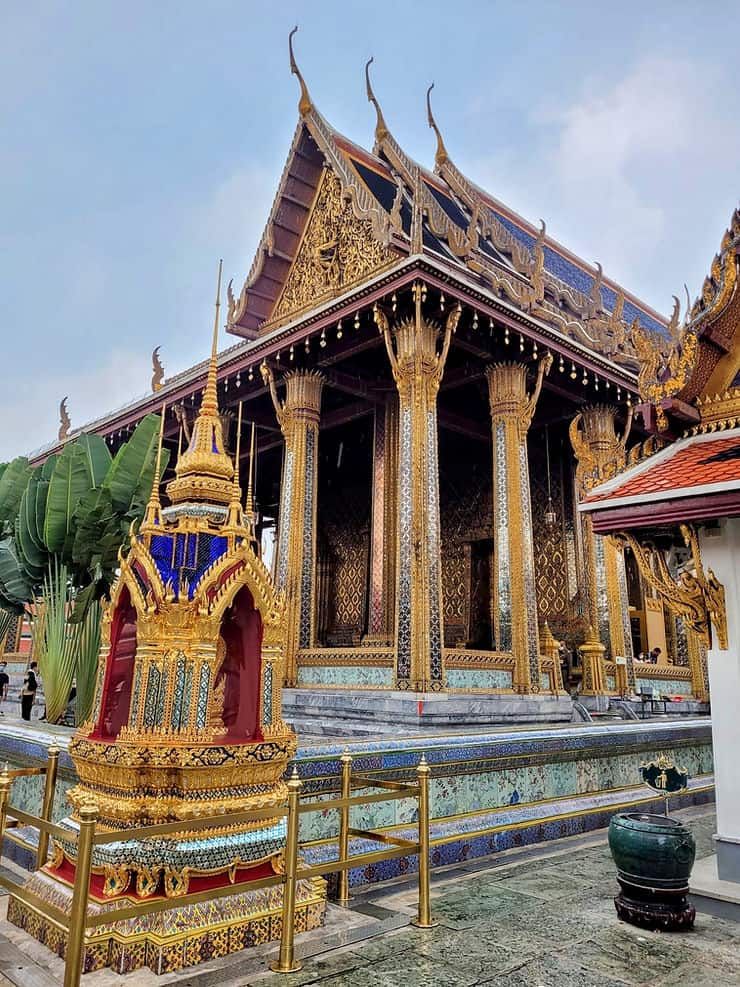
The Grand Palace complex includes various impressive and beautifully decorated buildings and temples. These include Wat Phra Kaew, the Phra Mondop buddhist library and the Phra Siratana Chedi – a golden stupa, built to house various relics of Lord Buddha.
The most significant temple within The Grand Palace is Wat Phra Kaew, commonly known as ‘The Temple of the Emerald Buddha’. The Emerald Buddha is the most important Buddha in the whole of Thailand, dating back to the 15th century. The Emerald Buddha is only 66cm high and has three ‘outfits’, which are changed in a ‘costume changing ceremony’ three times a year at the start of each season; winter, rainy and summer.
Wat Phra Kaew and the other temple buildings are surrounded by a gated gallery, enclosing the collection of buildings in their own, smaller complex within the grounds of The Grand Palace. Twelve Demon Guardian statues stand at the six gates, facing inwards, towards Wat Phra Kaew. The Demon Guardians protect the Emerald Buddha from any evil spirits.
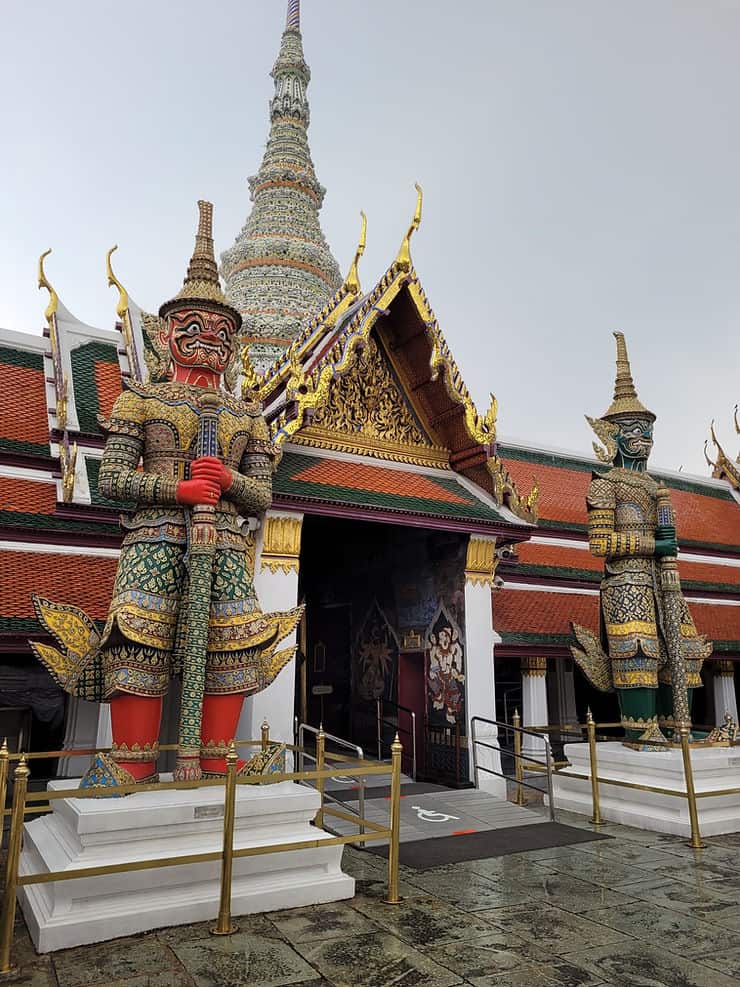
Although Wat Phra Kaew is the most popular temple building in The Grand Palace, you can easily spend several hours admiring all of the various temples and buildings here. Each building is so intricately decorated in brightly coloured mosaic, gold leaf or patterned tiles. There’s even a model of Cambodia’s iconic Angkor Wat complex! It is definitely one of the most impressive sites I have been to and I thoroughly enjoyed every moment of my visit here.
Before you leave, make a quick visit to the Queen Sirikit Museum of textiles. The museum is an exhibition of the history of textile arts in Thailand and South East Asia, with displays of textile patterns, and many items of the Queen’s royal wardrobe.
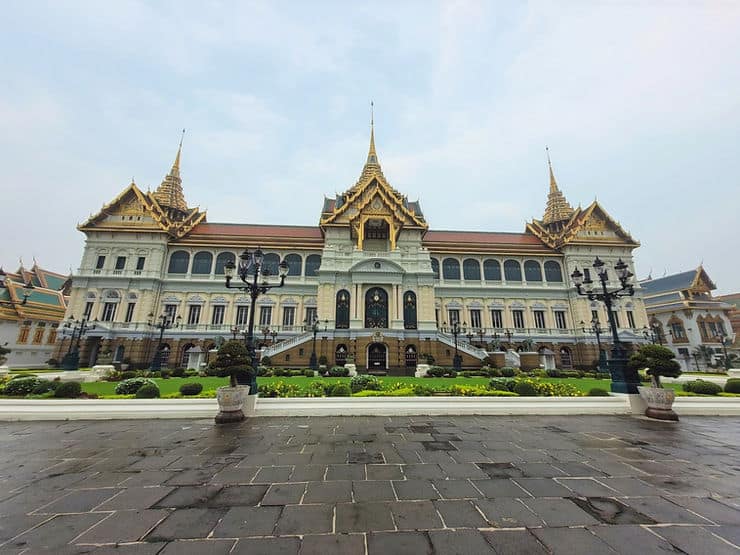
Important information for visiting The Grand Palace and Wat Phra Kaew (The Temple of the Emerald Buddha):
The Grand Palace opening hours: The Grand Palace and Wat Phra Kaew are both open every day from 8:30 AM to 3:30 PM
The Grand Palace ticket cost: 500 THB (£12) for foreigners (free for Thai people)
Tickets can be purchased at the entrance, however it is recommended to purchase tickets online to avoid long queues. Online tickets can be purchased up to 1 month in advance, and no less than 24 hours before your visit. An audio guide can be purchased at the entrance for 200 THB (£4.70), however I found the audio guide to be confusing to follow, so I turned it off!
How to get to The Grand Palace and Wat Phra Kaew:
The Grand Palace is located on Na Phra Lan Road, Phranakorn. The easiest way to get to The Grand Palace complex is by taxi or tuk tuk (as always, negotiate the price before you get in). The nearest Metro station is Sanam Chai, which is a 16 minute walk away from the entrance.
Dress code:
As with most Thai temples, there is a strict dress code for visiting The Grand Palace and Wat Phra Kaew. Make sure that you have your shoulders and knees covered (men and women). You also need to remove your shoes and hat when entering the temple.
- No sleeveless shirts, vests, or short ‘crop’ tops
- No see through tops or torn pants
- No hot pants, short shorts or mini skirts/dresses
- No tight trousers (including gym leggings and cycle shorts)
Drones: No drones are allowed in the whole of The Grand Palace Complex.
Photograph / videos: No photographs or videos are allowed to be taken inside Wat Phra Kaew (The Temple of the Emerald Buddha), however you can capture the outside of the temple.
Behaviour in the Temple of the Emerald Buddha: When entering Wat Phra Kaew, keep the noise down and talk in hushed tones. It is also respectful to kneel, but avoid facing your feet towards Buddha
Beware of Scams at The Grand Palace: Be careful of the many tuk tuk and taxi drivers circulating around the outside of The Grand Palace Complex. They will tell you that the Grand Palace is closed (especially if you are visiting in the morning). They will then offer to take you to another temple which is “open now” and then bring you back to the Grand Palace in the afternoon when it is open again. This is rubbish, and they are just trying to get you to take a ride with them. The Grand Palace will always update its opening hours and times on its website. Just ignore the drivers and continue straight to The Grand Palace entrance.
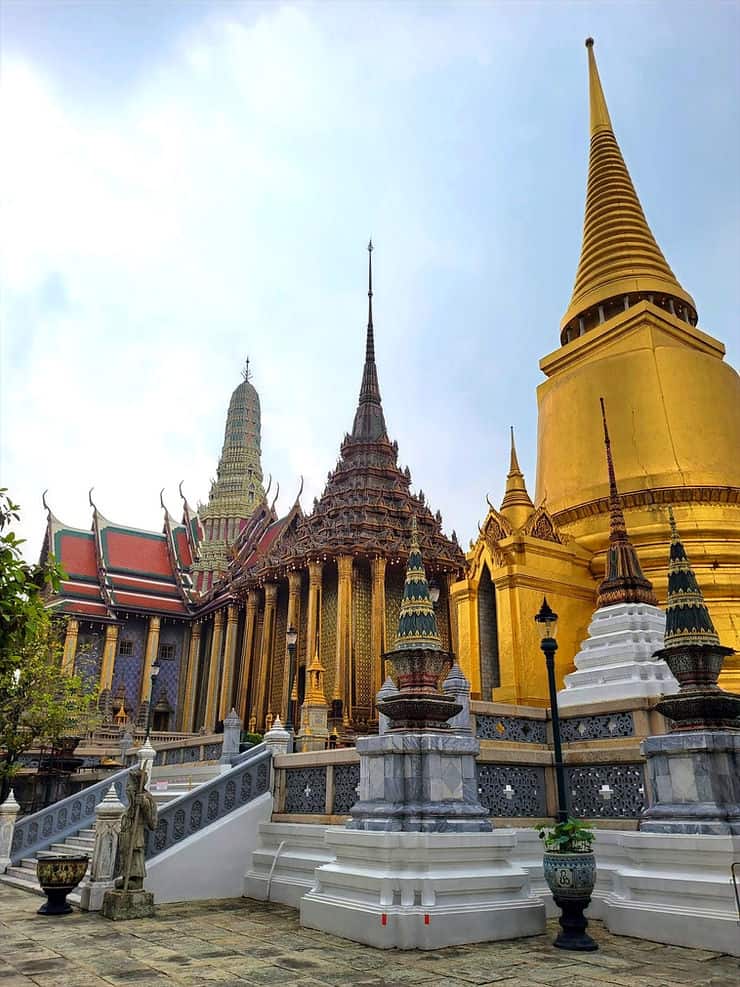
2. Wat Arun
Wat Arun (full name Wat Arun Ratchawararam Ratchaworawihan) sits on the Thonburi bank of the Chao Phraya River. Its impressive, and iconic, mosaic pagoda dominates the riverfront. The ancient temple is named after the Indian god of dawn, Aruna and often Wat Arun is referred to as ‘The Temple of the Dawn’ because of this.
The large pagoda in the centre of the temple complex sits at 104 metres tall and is surrounded by 4 smaller towers. The central pagoda and each of the 4 smaller towers have been painstakingly decorated with patterned porcelain tiles and shells. Only when you get close up do you realise how many individual tiles cover the temple – the work that went into it is seriously impressive!
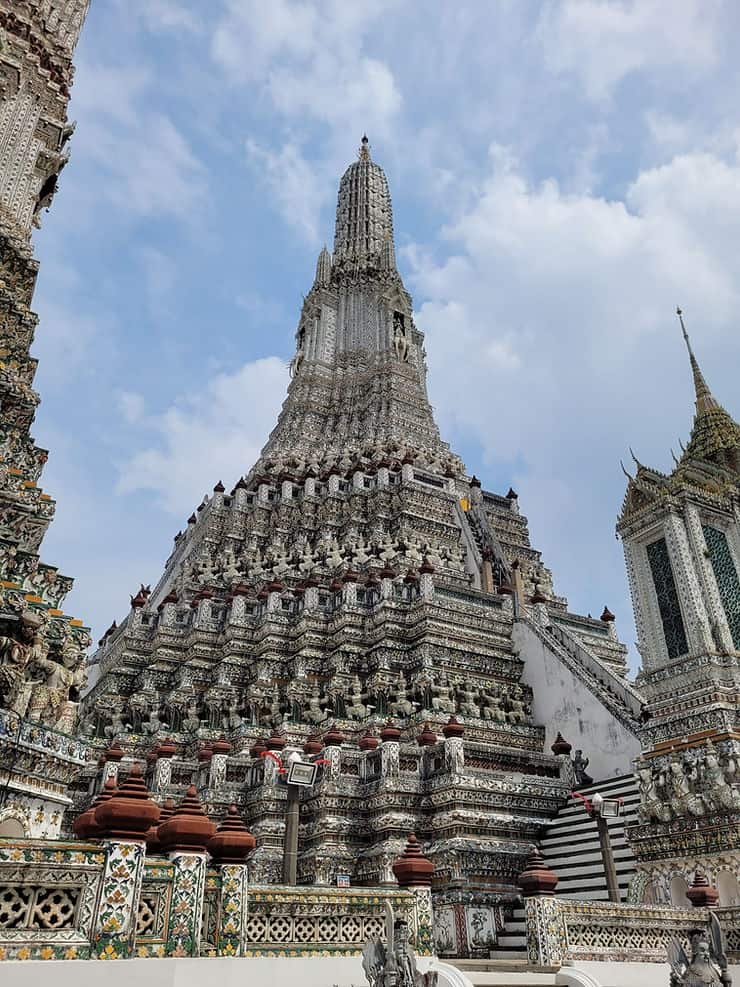
You can walk part way up the central tower, however, the steps are very steep, so you need to take care. One of the best places to capture a photo of the full pagoda is from the riverside green in front of the temple. After you have taken some photos, head to the small outdoor cafe next to the green for a drink or an ice cream!
The Pagoda is undoubtedly the main attraction here, but you can also visit the ordination hall and bell tower within the Wat Arun temple complex which are also very beautiful buildings.
If you want a different perspective of Wat Arun, come back in the evening. Wat Arun is particularly beautiful when seen from the other side of the river during sunset and at night, when the temple is illuminated and reflects on the river.
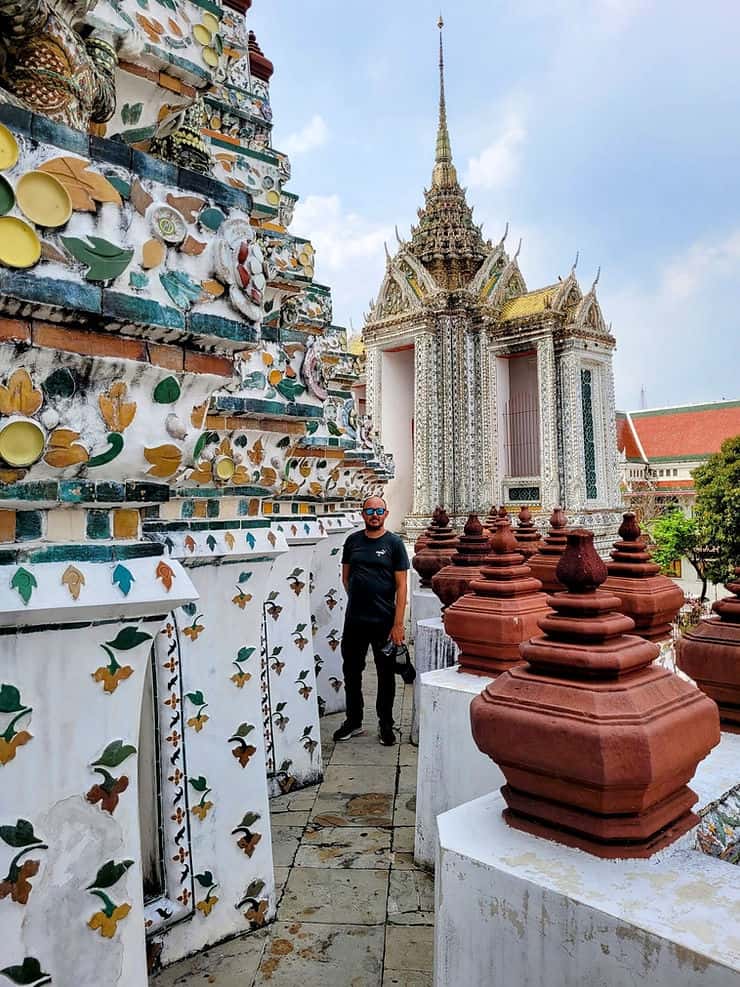
Important information for visiting Wat Arun:
Wat Arun opening hours: Wat Arun is open every day from 8:00 AM to 4:30 PM
Wat Arun ticket cost: The ticket for Wat Arun is 100 THB (£2.40) for foreigners
Tickets can be purchased at both entrances (from the road and from the ferry entrance)
How to get to Wat Arun from The Grand Palace: From the Grand Palace, walk 10 minutes along Maha Rat Road, next to the walls of The Grand Palace complex until you reach Tha Tien pier. At the pier, take the ferry across the river to Wat Arun Pier. The ferry crossing takes less than 5 minutes and runs every 10-15 minutes. A one way ticket costs just 5 THB (£0.12)
How to get to Wat Arun: If you are visiting Wat Arun on a separate occasion, there are two metro stations you can use to reach Wat Arun. Sanam Chai station is on the same side of the river as Wat Pho and The Grand Palace. If you arrive at this metro station, jump off and walk 8 minute alongside the river to Tha Tien pier and catch the ferry across as detailed above. On the opposite side of the river is the Thanon Itsaraphap metro station. From this station, Wat Arun is an 11 minute walk away.
Dress code: Both men and women should have their legs and shoulders covered. No vests/singlets / cropped tops. No tight leggings/cycle shorts. No sea-through or ripped clothing. Shoes and hats must be removed when entering the temples.
Behaviour in Wat Arun: Visitors need to be respectful and quiet when in the temples and grounds.
Beware of Scams at Wat Arun temple: There are lots of people selling sightseeing boat tours from Tha Tien Pier. They offer hour-long tourist trips up and down the Chao Phraya River. Just be careful with these and make sure that if you do decide to join a sightseeing boat, confirm all the details beforehand. I heard stories of boats stopping in the middle of the river and refusing to continue until they were given more money.
The same people will also try and convince you that the ferry boat is not running on that day and the only way across the river is to join their sightseeing boat or hire a private taxi boat. This is not true, however, they are very persistent. I even had one woman follow me into the ferry station still insisting that the ferry wasn’t running – whilst I was paying for my ferry ticket!
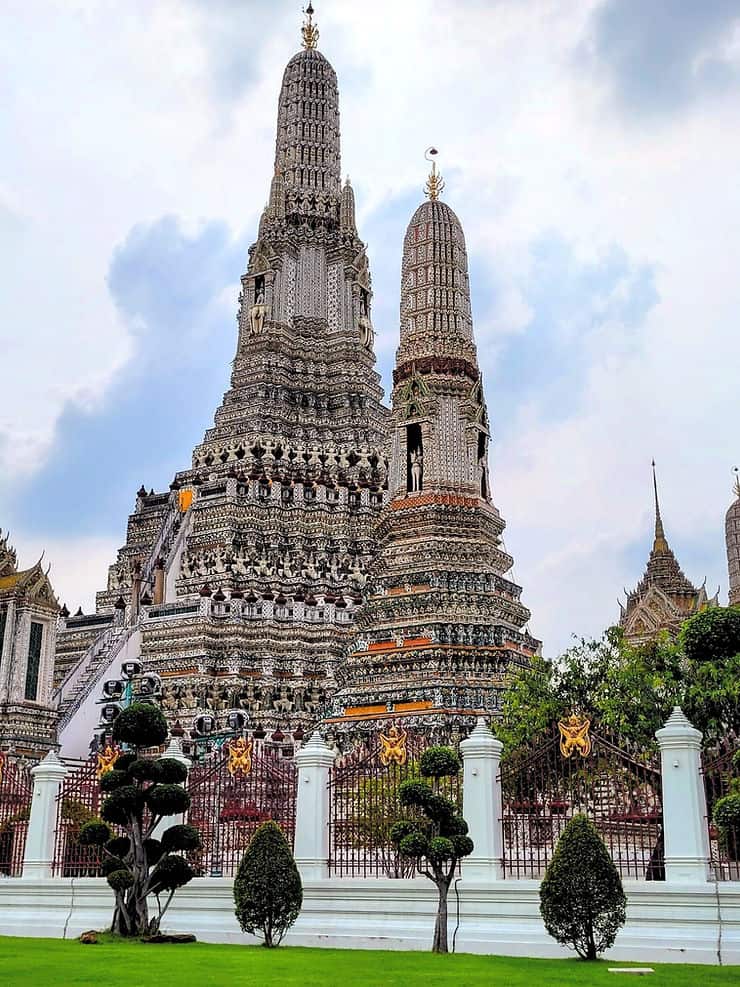
3. Wat Pho & The Temple of the Reclining Buddha
Wat Pho is the oldest – and one of the most visited – temples in Bangkok. It not only holds religious significance, but it’s also an important place for Thai medicine and education. There are over 1300 inscriptions detailing information on medical and historical science all over the temple complex.
If you only have one day in Bangkok, I’d highly recommend including a visit to Wat Pho in your itinerary!
The centrepiece of Wat Pho lies in the ordination hall where the Reclining Buddha can be seen. The Reclining Buddha is 46 metres long and the feet of the Buddha are carved with inscriptions and mother of pearl. The masterpiece is really quite special and you have to see it in person to appreciate the scale of it.
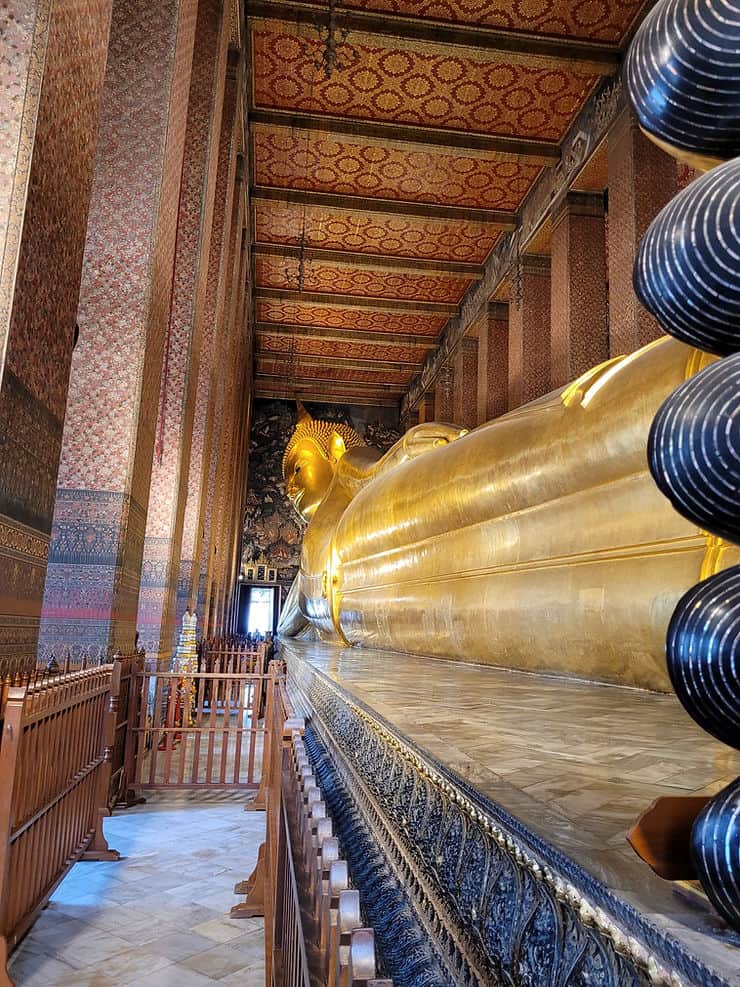
Elsewhere in the Wat Pho temple complex is a selection of impressive statues, temples and buildings, including four tiled pagodas, known as Phra Maha Chedi Si Rajakarn. Each of these pagodas stands at 42 metres high and are surrounded by a white wall, enclosing them from the rest of the temple complex. Whilst the pagodas are not as large or impressive as Wat Arun, they are still incredibly beautiful to witness.
Another notable building within the Wat Pho complex is the Phra Ubosot Assembly Hall. The focal point of the grand assembly hall is a golden Buddha, seated on a tiered golden pedestal. It is said that the ashes of King Rama I are kept under the pedestal.
Located at the back of Wat Pho is the Wat Pho Thai Traditional Medical and Massage School. Here, students can learn Thai Pharmacy, Thai medical practice, Thai Midwife Nurse and Thai Massage. For visitors, traditional Thai massages are offered, so you can treat yourself to a relaxing foot massage after a full day of exploring temples!
Important information for visiting Wat Pho:
Wat Pho opening hours: Wat Pho is open every day from 08:00 AM to 6:30 PM
Wat Pho ticket cost: Tickets to visit Wat Pho and the Temple of the Reclining Buddha are 200 THB (£4.70). Tickets for Wat Pho can be purchased at the entrance
How to get to Wat Pho from Wat Arun: If you are following this route then you will be visiting Wat Pho after Wat Arun. From Wat Arun ferry pier, board the ferry across the river to Tha Tien Pier. The ferry departs every 10-15 minutes and costs 5 THB (£0.12) one way From Tha Tien, it is just a 2 minute walk to Wat Pho entrance.
How to get to Wat Pho: If you are going straight to Wat Pho, you can reach it by tuk tuk or taxi. The nearest Metro station is Sanam Chai, which is a 5 minute walk away from the entrance.
How to get to Wat Pho from The Grand Palace: The Grand Palace entrance is a 10 minute walk from Wat Pho.
Dress code: Similar to The Grand Palace and Wat Phra Kaew, you will be required to dress politely. Both men and women should cover their knees and shoulders. You will need to remove your shoes and hat when entering a temple
Engaging with Monks at Wat Pho: Women are not allowed to enter areas where monks are performing their duties and no physical contact is allowed between women and monks. You must talk in quite, respectful tones when addressing, or in the presence of, a monk.
Massage at Wat Pho: There is a traditional Thai massage school at Wat Pho, so if your feet are aching from lots of walking, get a foot massage before leaving. A foot massage is 280 THB (£6.60) for 30 minutes.
Beware of Scams at Wat Pho: As Wat Pho is close to The Grand Palace, you will experience the same array of tuk-tuk and taxi drivers trying to convince you that the temple is closed. Ignore them and walk straight to the entrance.
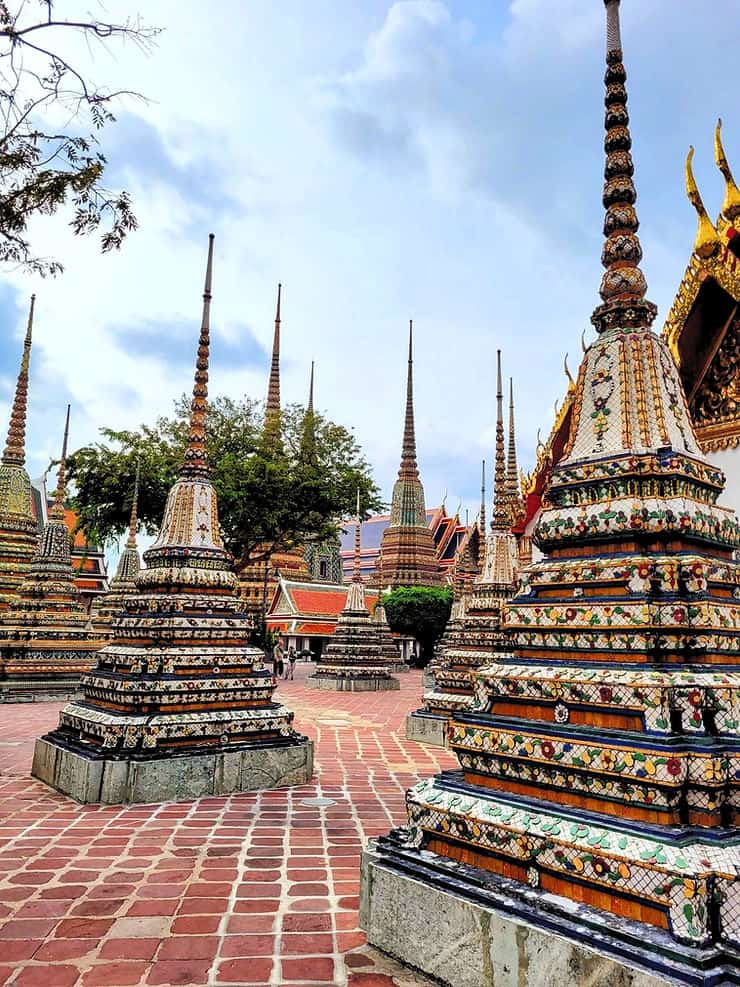
The Grand Palace & Wat Phra Kaew, Wat Arun and Wat Pho are three of the best temple complexes I had the chance to visit during my three months in Thailand. Each one is unique and incredibly beautiful. You simply cannot go to Bangkok without visiting these three temples!
To top of your day, why not book a sunset cruise down the Chao Phraya river. During your cruise, you will get stunning views of both The Grand Palace and Wat Arun illuminated as night falls.
Top tips for visiting Bangkok’s temples:
1. Go early!
As with most popular tourist sights, you will not be alone in visiting these temples. The Grand Palace and the Temple of the Emerald Buddha are extremely popular, so arrive early. Also, make sure that you book your ticket online so that you don’t waste time queuing at the entrance.
2. Follow the Itinerary
Most people will visit Wat Pho and The Grand Palace together in one day, and they will usually begin with The Grand Palace as this closes first. This means that everyone visiting The Grand Palace in the morning will head to Wat Pho afterwards. My itinerary will take you to Wat Arun next, allowing some of the busier crowds in Wat Pho to disperse by the time you arrive later in the afternoon.
3. Dress appropriately
As I have detailed already – you must make sure that you are dressed respectfully when visiting all these temples (and others throughout Thailand). As you will be removing your shoes frequently to enter the temples, pick shoes which you can easily take on and off. Whilst a hat is a good idea to protect your head from the sun, remember to remove it before entering a temple.
4. Carry water
The temperatures in Bangkok can get high and temple-hopping is thirsty work! Make sure you stay hydrated and take rest in the shade when you can. Taking an umbrella is also a great idea to give you a bit of extra shade in the heat of the day.
5. Watch out for scams
I’ve already highlighted a couple of the scams which we came into contact with, but just be aware of others too. I’m not saying don’t trust anyone, but if you do your research and plan your route / transport / itinerary and know what to expect, then this will help you to spot anything which doesn’t feel quite right.
6. Check out my essential tips for travelling in Southeast Asia!
From what foods to avoid to how to manage your budget, these 50 travel tips will help you plan your trip to Southeast Asia and include helpful travel hacks to make your life easier.

